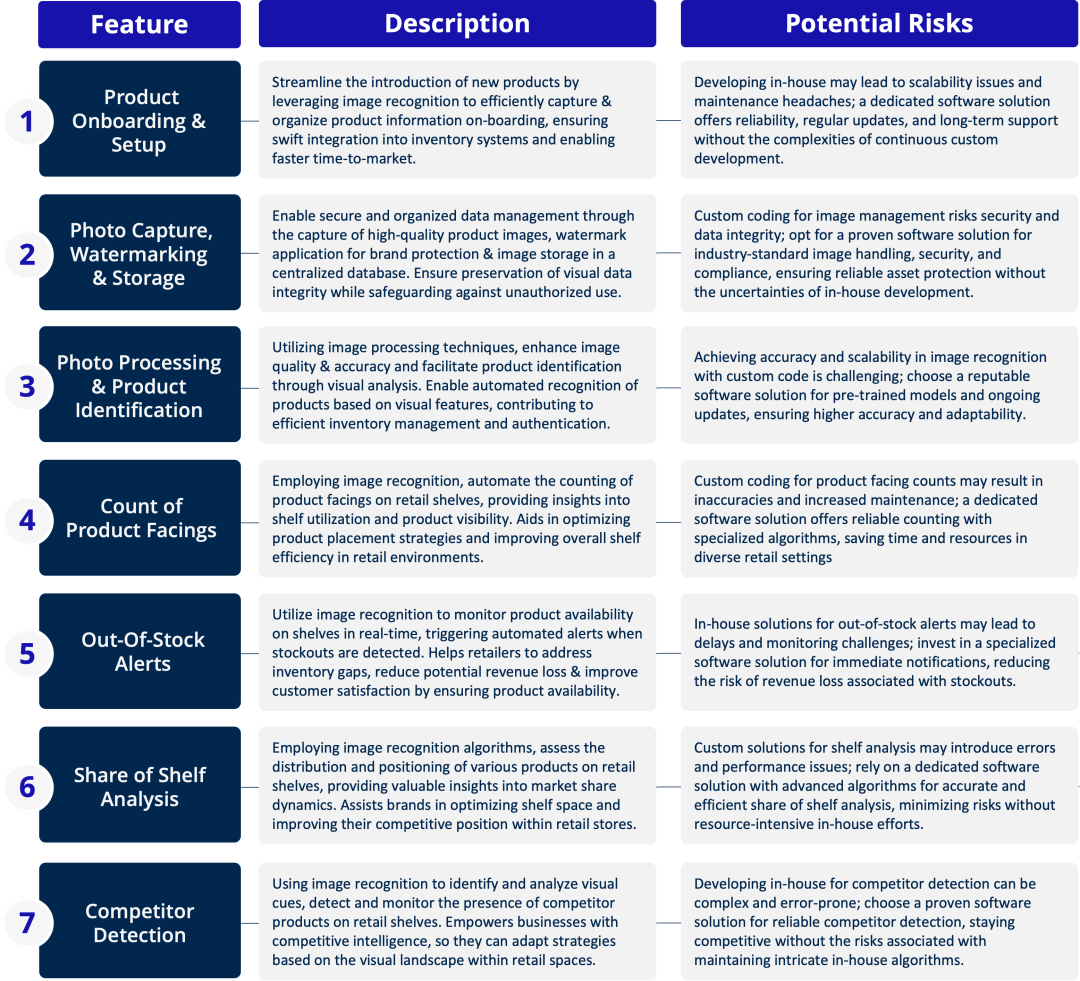Across the Retail landscape, there is a huge range of in-store tasks that need to be executed by Consumer Product companies on a daily basis to deliver sales strategies and optimise trade investments. And, with 60% of store checks still relying on labor-intensive manual measurements, essential time is being wasted. When it comes to the software involved in these tasks, companies can be tempted to develop their own systems in-house. This is often driven by a desire for control and customisation to their unique needs, and the hope that they will be easier to integrate into existing legacy systems.
The prospect of total autonomy over the development process, from conception to development, can be alluring, especially when it is presented as a long-term investment (with the belief that the company will be less reliant on others in future). Conceptually, this all makes sense. However, the reality is that there are significant challenges that make it more complex, less cost-effective and less efficient than it seems.
For example, think of a word processor, the kind that you might use daily to execute a number of tasks. Now, consider the monumental amount of work that would go into constructing an in-house word processor from scratch. While it seems implausible in today’s tech landscape dominated by giants like Google Docs and Microsoft Word, some companies venture into similar endeavours with image recognition (IR) software, despite its complexities.
What You Need From an IR Solution & The Risks of In-House Development
IR holds massive value potential for Consumer Products, revolutionizing various aspects of operations and customer engagement. By employing image recognition technology, companies can streamline inventory management, enhance shelf visibility, and ensure planogram compliance in retail environments.
However, Consumer Product companies looking to take the route of building their image recognition software internally need to be aware of the numerous risks that path presents.
From the outset, resources allocated to hire & retain the talent required for expert machine learning and computer vision often need to be substantial, and they are still no guarantee of an effective end-product. Additionally, achieving high accuracy rates in real-world scenarios requires extensive training data and rigorous testing – all of which needs to be sourced in-house. With the level of investment required to even attempt to create an effective, it can be frustrating to shareholders (and to the teams involved) when the resulting product isn’t up to expectations.
Here are the top 7 essential features of an image recognition solution, and the risks that accompany developing them in-house:

Aforza Studio: Your Digital Content Execution Hub
Even with these risks on the table, the absence of a common point solution for image recognition in the Consumer Products industry has required that companies purchase and integrate multiple solutions.
This is where Aforza Studio comes in. A compelling alternative to in-house development, Aforza Studio is a pre-built platform tailored specifically to the needs of the Consumer Products industry. Leveraging cutting-edge technology, Studio ensures cost-effectiveness, faster implementation and access to specialised expertise. Through uploading just a single asset, Aforza can can automate actions in the field for customers with an end-to-end setup (such as cater for follow up visits if your products on the shelf are below a certain percentage) – no more time-wasting manual actions and calculations.
Aforza Studio excels in capturing and processing high volumes of store images, flawlessly detecting products and understanding share of shelf and planogram compliance. Its ability to tag images with actionable attributes enables teams to take proactive action to resolve stock and availability issues, driving operational excellence and revenue growth.
This is enhanced by our partnership with ParallelDots, a renowned AI company specializing in advanced IR solutions for consumer products and retail brands, and their product ShelfWatch – ParallelDots’ ShelfWatch uses Computer Vision to analyse images of retail shelf displays that generates perfect store KPI insights in real-time.
“In the fast-paced retail world, our ShelfWatch and Aforza Studio partnership offers Consumer Products companies a futureproof image recognition solution, blending advanced capabilities with continuous feature and functionality enhancements. This collaboration sidesteps the complexities and costs of in-house development, providing a ready-to-deploy, state-of-the-art service tailored to the industry’s unique needs,” said Angam Parashar, Co-Founder & CEO of ParallelDots. “Leveraging this leading platform enables companies to stay ahead of the curve, ensuring growth, operational excellence, and superior customer engagement with unparalleled efficiency and accuracy.”
Here are some of the key features of Aforza Studio:

The Business Impact
With Aforza Studio, Consumer Product companies can take action on share of shelf intelligence, empowering them to:
-
Protect up to 5% of revenues by immediately addressing out-of-stock issues with proactive actions.
-
Ensure promoted stock is available in store and visible, reclaiming up to 70% of wasted trade investment.
-
Increase customer NPS and prevent brand switching to a competitor when faced with an out-of-stock situation.
-
Save thousands with just a one-time Aforza Studio set-up. Configure workflows, allow members of sales teams to do what they do best – sell.
In conclusion, image recognition technology presents a transformative opportunity for the Consumer Products industry. Its ability to streamline operations, improve customer engagement, and unlock valuable insights makes it an indispensable tool for companies striving to stay competitive in today’s fast-paced market.
By embracing established IR solutions like Aforza Studio, Consumer Products companies can harness the power of their visual data to drive growth, enhance efficiency, and deliver exceptional experiences to consumers worldwide. As the industry continues to evolve, those who leverage the potential of image recognition can be confident that they are at the forefront of innovation.

